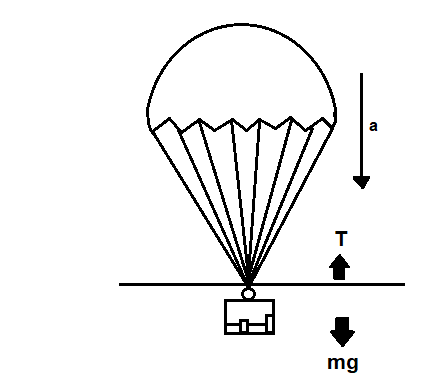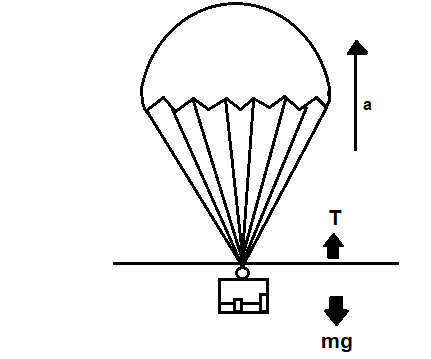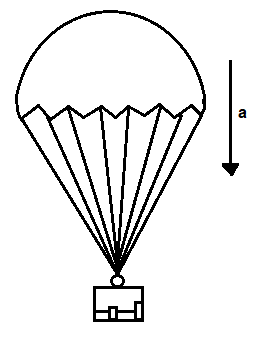Answer
413.1k+ views
Hint: As the parachute is moving downwards initially, the force exerted by it will be gravitational force minus upward thrust. Then a ballast mass is dropped and the parachute now moves upwards with an upward acceleration, here the new mass will be initial mass minus ballast mass and the force exerted by the parachute will be the upward thrust minus gravitational force. Use this info to solve the given problem.
Complete step by step answer:We are given a parachute of mass m that starts coming down with a constant acceleration a.
We have to determine the ballast mass to be released from the parachute to have an upward acceleration of the same magnitude.
Initially the acceleration is downwards and the parachute moves downwards. Let the upward thrust be T.

Force is the product of mass of the body and acceleration of it.
Therefore, Force exerted by parachute before dropping the mass is
$ma = mg - T \Rightarrow eq\left( 1 \right)$
Let the ballast mass which is to be released is ${m^1}$
Now the final mass of the parachute will be $m - {m^1}$
After dropping the mass, the acceleration now is upwards and the parachute moves upwards.

Therefore, Force exerted by parachute after dropping the mass is
$
\left( {m - {m^1}} \right)a = T - \left( {m - {m^1}} \right)g \\
\Rightarrow ma - {m^1}a = T - mg + {m^1}g \Rightarrow eq\left( 2 \right) \\
$
On adding equation 1 with equation 2, we get
$
ma - {m^1}a + \left( {ma} \right) = T - mg + {m^1}g + mg - T \\
\Rightarrow 2ma - {m^1}a = {m^1}g \\
\Rightarrow {m^1}g + {m^1}a = 2ma \\
\Rightarrow {m^1}\left( {g + a} \right) = 2ma \\
\Rightarrow {m^1} = \dfrac{{2ma}}{{\left( {g + a} \right)}} \\
\therefore {m^1} = \dfrac{{2ma}}{{a + g}} \\
$
Therefore, the ballast mass to be released from the parachute to have an upward acceleration is $\dfrac{{2ma}}{{a + g}}$
Hence, the correct option is Option A.
Note:When you are adding two equations, then the LHS of one equation must be added to the LHS of another equation and the same with RHS too. Do not swap the places as the result may go wrong. Thrust pushes the parachute upwards by pushing the gases downwards in the opposite direction and gravitational force pulls the parachute downwards towards the centre of earth. Be careful with this.
Complete step by step answer:We are given a parachute of mass m that starts coming down with a constant acceleration a.
We have to determine the ballast mass to be released from the parachute to have an upward acceleration of the same magnitude.
Initially the acceleration is downwards and the parachute moves downwards. Let the upward thrust be T.

Force is the product of mass of the body and acceleration of it.
Therefore, Force exerted by parachute before dropping the mass is
$ma = mg - T \Rightarrow eq\left( 1 \right)$
Let the ballast mass which is to be released is ${m^1}$
Now the final mass of the parachute will be $m - {m^1}$
After dropping the mass, the acceleration now is upwards and the parachute moves upwards.

Therefore, Force exerted by parachute after dropping the mass is
$
\left( {m - {m^1}} \right)a = T - \left( {m - {m^1}} \right)g \\
\Rightarrow ma - {m^1}a = T - mg + {m^1}g \Rightarrow eq\left( 2 \right) \\
$
On adding equation 1 with equation 2, we get
$
ma - {m^1}a + \left( {ma} \right) = T - mg + {m^1}g + mg - T \\
\Rightarrow 2ma - {m^1}a = {m^1}g \\
\Rightarrow {m^1}g + {m^1}a = 2ma \\
\Rightarrow {m^1}\left( {g + a} \right) = 2ma \\
\Rightarrow {m^1} = \dfrac{{2ma}}{{\left( {g + a} \right)}} \\
\therefore {m^1} = \dfrac{{2ma}}{{a + g}} \\
$
Therefore, the ballast mass to be released from the parachute to have an upward acceleration is $\dfrac{{2ma}}{{a + g}}$
Hence, the correct option is Option A.
Note:When you are adding two equations, then the LHS of one equation must be added to the LHS of another equation and the same with RHS too. Do not swap the places as the result may go wrong. Thrust pushes the parachute upwards by pushing the gases downwards in the opposite direction and gravitational force pulls the parachute downwards towards the centre of earth. Be careful with this.
Recently Updated Pages
What number is 20 of 400 class 8 maths CBSE

Which one of the following numbers is completely divisible class 8 maths CBSE

What number is 78 of 50 A 32 B 35 C 36 D 39 E 41 class 8 maths CBSE

How many integers are there between 10 and 2 and how class 8 maths CBSE

The 3 is what percent of 12 class 8 maths CBSE

Find the circumference of the circle having radius class 8 maths CBSE

Trending doubts
Which are the Top 10 Largest Countries of the World?

Fill the blanks with the suitable prepositions 1 The class 9 english CBSE

One cusec is equal to how many liters class 8 maths CBSE

Differentiate between homogeneous and heterogeneous class 12 chemistry CBSE

Difference between Prokaryotic cell and Eukaryotic class 11 biology CBSE

Give 10 examples for herbs , shrubs , climbers , creepers

The Equation xxx + 2 is Satisfied when x is Equal to Class 10 Maths

One Metric ton is equal to kg A 10000 B 1000 C 100 class 11 physics CBSE

Change the following sentences into negative and interrogative class 10 english CBSE




